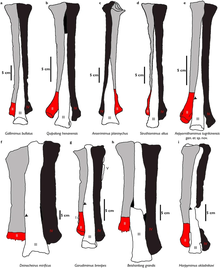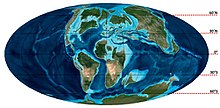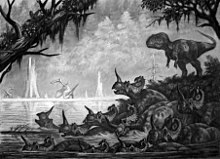Qiupalong
| Qiupalong Temporal range: Late Cretaceous
~72 to 66 Ma - | |
|---|---|

| |
| The holotype specimen on display in China | |
| Scientific classification | |
| Domain: | Eukaryota |
| Kingdom: | Animalia |
| Phylum: | Chordata |
| Clade: | Dinosauria |
| Clade: | Saurischia |
| Clade: | Theropoda |
| Clade: | †Ornithomimosauria |
| Family: | †Ornithomimidae |
| Genus: | †Qiupalong Xu et al., 2011 |
| Type species | |
| †Qiupalong henanensis Xu et al., 2011
| |
Qiupalong (meaning "dragon from the Qiupa Formation") is an
Discovery

The
The Qiupa Formation preserves a wide variety of dinosaur eggs, many of which have been named as

In 2017, another team of researchers including
When these newer specimens were described, the authors noted that they bore significant morphological similarities to the holotype of Qiupalong. The foot claws of the new specimens in particular were nearly identical to those of the holotype. As a result, they referred these new remains to the genus, but they did not assign it to the type species. The significance of this referral was noted by the authors. It extended the temporal range of Qiupalong from the middle Campanian to the latest Maastrichtian - a span of roughly 10 million years. This would also make Qiupalong the only genus of ornithomimid known from both Asia and Laramidia.[2]
In 2023, the
Description
Qiupalong was very similar to derived North American
Xu and colleagues diagnosed the genus by the following
Holotype

The
The taphonomic conditions vary for the different bones of the holotype. The pelvic elements are crushed and not completely preserved, and the right side of these bones are more intact than those of the left side. The leg bones are mostly complete and several of the ankle elements were partially articulated.[1]
In comparison to other ornithomimids, Qiupalong has a mix of derived and plesiomorphic features. The toe claws are curved downwards, which resembles the condition seen in basal ornithomimosaurs and is unlike other derived ornithomimids from Asia. The metatarsals display the
In their description of the holotype, Xu and colleagues made numerous comparisons to the holotype of the
Referred material
Several
The UALVP specimens were from the
These specimens were referred to Qiupalong sp. because they were not diagnostic to the species level, but they strongly resembled some of the bones of the holotype of Q. henanensis. In particular, UALVP 52861 (a pedal ungual) was noted to be almost identical in morphology to those known from the holotype. However, McFeeters and colleagues noted that several of the bones of CMN 8902 were not able to be compared with the holotype of Qiupalong because the specimen consists of bones that are not present in the holotype (the vertebrae and bones of the arm). The authors also note that the morphology of these elements is broadly similar to other North American ornithomimosaurs and if CMN 8902 is an individual of Qiupalong, it supports a close relationship with Struthiomimus and Ornithomimus.[2]

McFeeters and colleagues also remark that one of the listed
Most recently, in
The specimen itself, AEIM 2/1045, was sectioned for histological study to determine its ontogenetic age. Averianov and colleagues suggested, based on the presence of active secondary remodeling and the lack of an external fundamental system, that the individual was a young adult which was still actively growing when it died. They do not specifically refer it to Qiupalong, but they do remark that it bears the most similarity to it out of all ornithomimids.[3]
Classification
In their description of the
They recovered Qiupalong in a clade with Struthiomimus and Ornithomimus, which they refer to as the "North American clade" (after Kobiyashi and Lü who recovered the same clade). This clade is diagnosed by a very acute angle between pubic shaft and boot and a tip of anterior extension of the pubic boot. They also comment on the discovery of some material from the Dinosaur Park Formation, that may also belong to this clade.[1] This material would later be described and referred to "Qiupalong sp.".[2]
| Ornithomimosauria |
| |||||||||||||||||||||||||||||||||||||||||||||
More recent phylogenetic analyses have recovered mostly similar positions for Qiupalong (i.e. in a derived position closely-related to North American taxa). Examples of such analyses include Brusatte and colleagues (2014),[8] Serrano-Brañas and colleagues (2020),[9] and Hattori and colleagues (2023).[10]
Averianov and Dieter-Sues recovered a slightly different phylogeny
| Ornithomimidae |
| ||||||||||||
Paleoecology
Diet
The skull of Qiupalong is not known, although it is assumed that it was likely similar to other
Evolution and dispersal

Although the first remains of Qiupalong to be described were from
Qiupalong is not the only genus to exist on both continents. Both Saurolophus and Parasaurolophus (or possibly Charonosaurus) are known to have migrated from North America to Asia. Furthermore, it has been suggested that animals like Sinoceratops, Olorotitan, and Tarbosaurus are the descendants of animals which immigrated to Asia during this period. The exact time that this migration occurred is uncertain because the geochronology of Cretaceous Asia has not been studied as thoroughly as the geochronology of North America.[3][14]
Paleoenvironment

- Belly River Group
The exact age of the North American specimens of Qiupalong is not confidently known. However the ages of the Oldman Formation and the Dinosaur Park Formation as a whole is relatively confidently known to have been deposited between 79.50 and 75.46 million years ago.[14]
The Dinosaur Park and Oldman formations are composed of sediments that were derived from the erosion of the mountains to the west. They were deposited on an alluvial to coastal plain by river systems that flowed eastward and southeastward to the Bearpaw Sea, a large inland sea that was part of the Western Interior Seaway. That sea gradually inundated the adjacent coastal plain, depositing the marine shales of the Bearpaw Formation on top of the Dinosaur Park Formation, which is in turn on top of the Oldman Formation.[15]
- Qiupa Formation
The
Contemporary fauna
- Belly River Group

The earliest record of Qiupalong is from either the
The remains of Qiupalong are from differing localities, some of which are unknown, but most of the material that is confidently assigned to individual localities are from the lower half of the Dinosaur Park Formation, about 20 meters above the contact with the Oldman Formation.[1] This corresponds to what has been called "Megaherbivore Assemblage Zone 1", the "Sandy zone", or the "Centrosaurus-Corythosaurus zone". This faunal stage would have obviously included Centrosaurus and Corythosaurus, but other animals from this time period included Euoplocephalus, Dyoplosaurus, Panoplosaurus, Chasmosaurus, Lambeosaurus, and Parasaurolophus.[14][17] These herbivores would have been preyed upon by the tyrannosaurids Gorgosaurus and Daspletosaurus, which are known to have coexisted.[18]
Small dinosaurs in general appear to have overlapped in their temporal distribution much more significantly. Most remains from small theropods are from the lower half of the Dinosaur Park Formation, where the remains of Qiupalong are believed to have originated. Qiupalong is believed to have coexisted with
- Qiupa Formation

The
This environment was also home to a variety of other animals. These would have included
See also
- 2011 in archosaur paleontology
- Cretaceous–Paleogene extinction event
- Institute of Vertebrate Paleontology and Paleoanthropology
- List of Asian dinosaurs
- Timeline of ornithomimosaur research
References
- ^ .
- ^ .
- ^ ISSN 2587-5779.
- ^ .
- PMID 36122246.
- ISBN 978-0691180311.
- ^ Kobayashi, Yoshitsugu; Lü, Jun−Chang (2003). "A new ornithomimid dinosaur with gregarious habits from the Late Cretaceous of China". Acta Palaeontologica Polonica. 48 (2): 235–259.
- S2CID 8879023.
- S2CID 218968100.
- PMID 37679444.
- ^ .
- .
- ^ .
- ^ PMID 29166406.
- ISBN 0-253-34595-2.
- ^ a b Alroy, John; Carrano, Matthew; Benson, Roger; Mannion, Philip (2021). "Qiupa, Luanchuan Basin (Cretaceous of China)". The Paleobiology Database.
- .
- S2CID 85665879.
- .
- PMID 23314810.
- .









